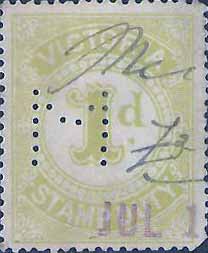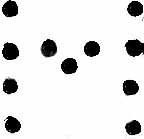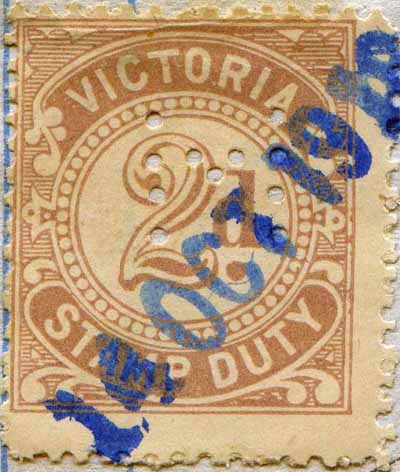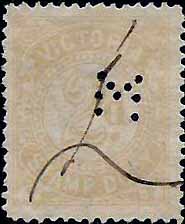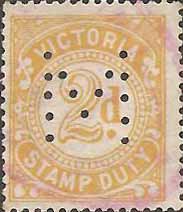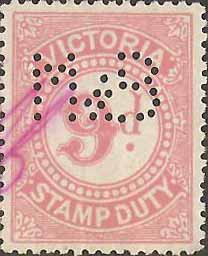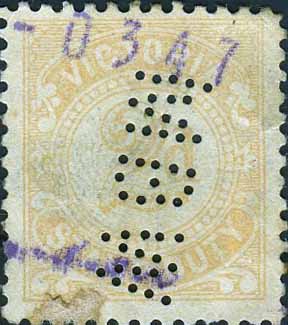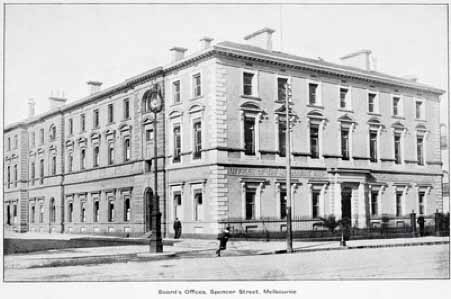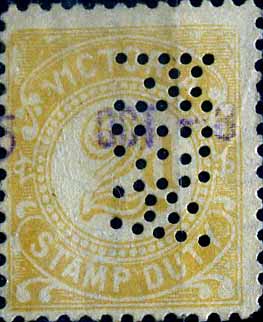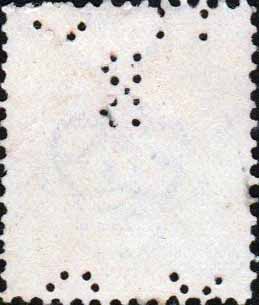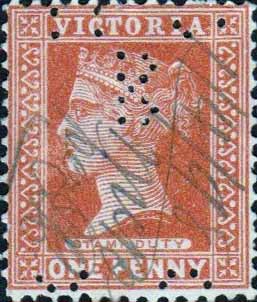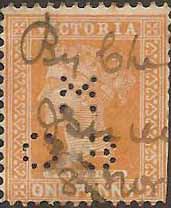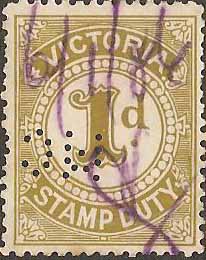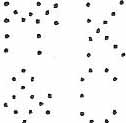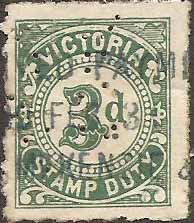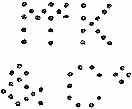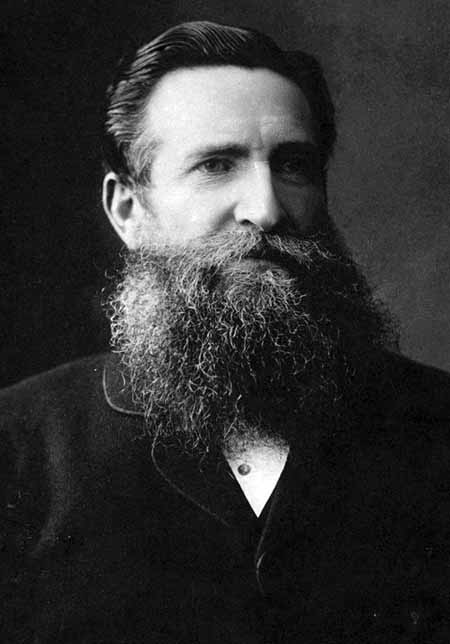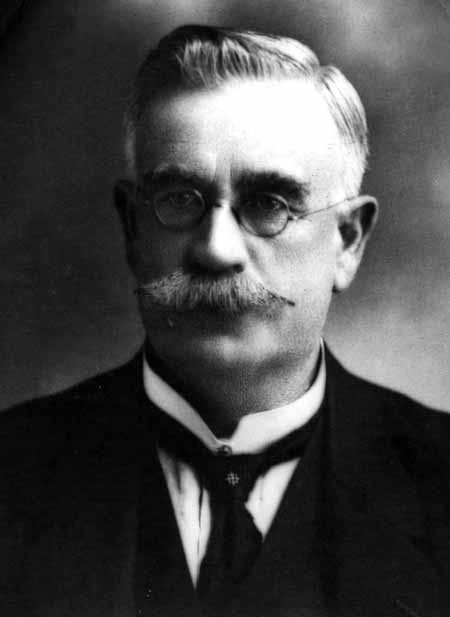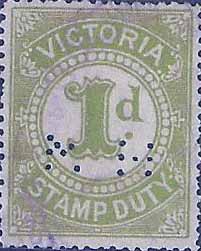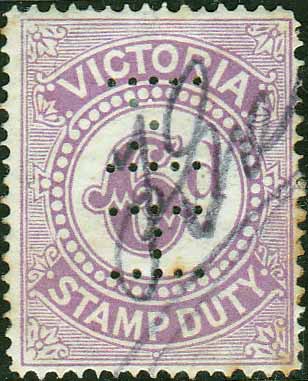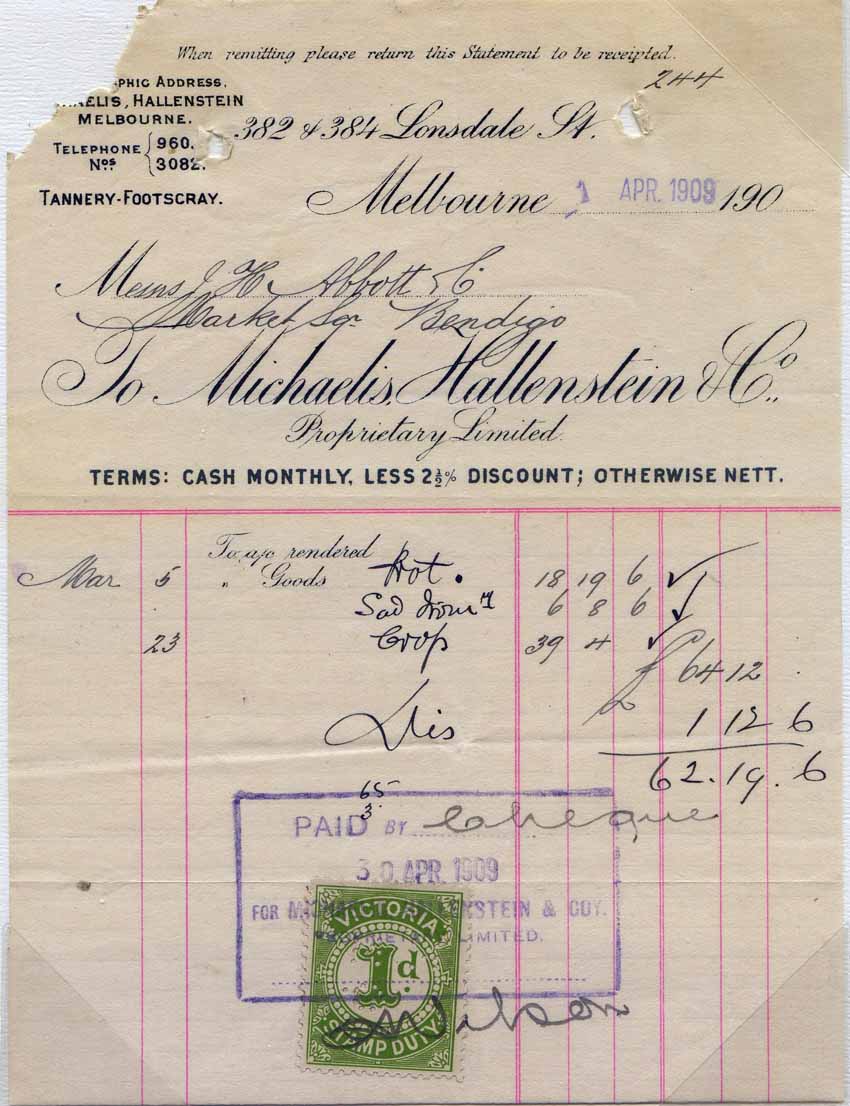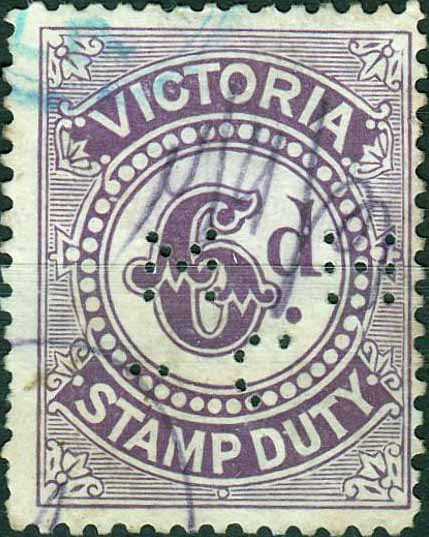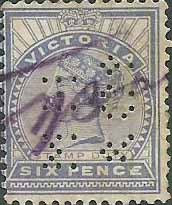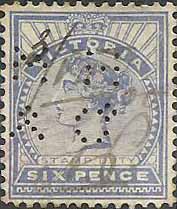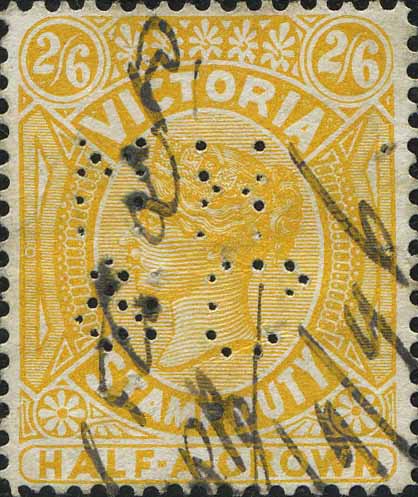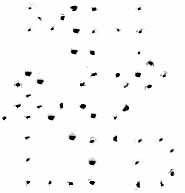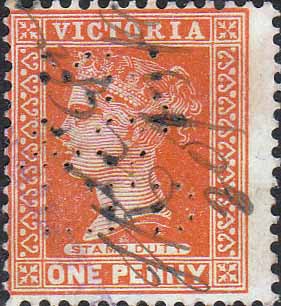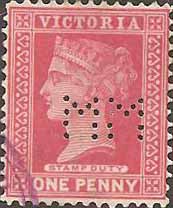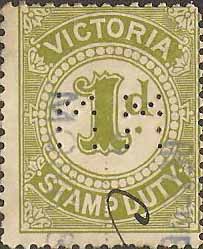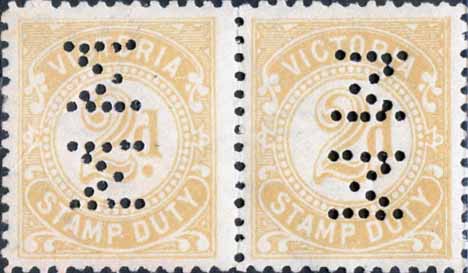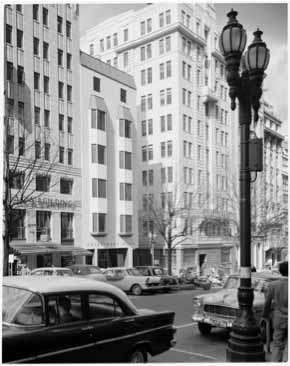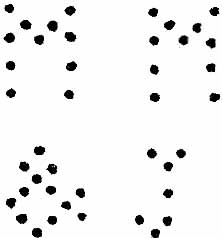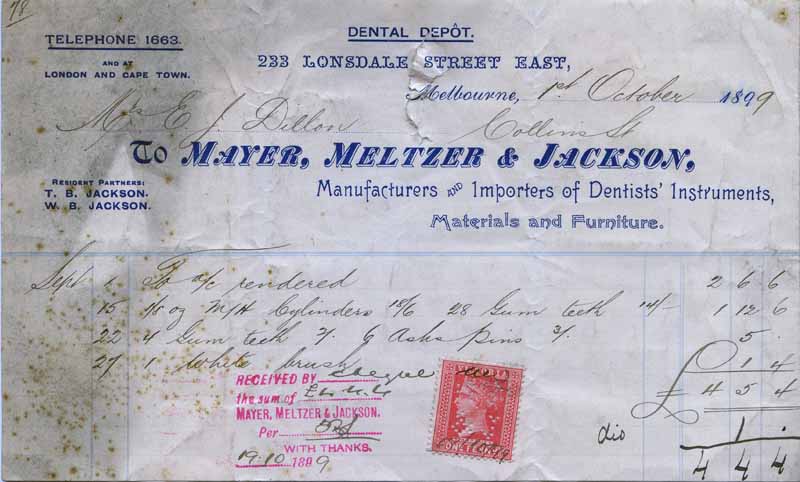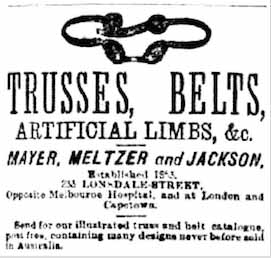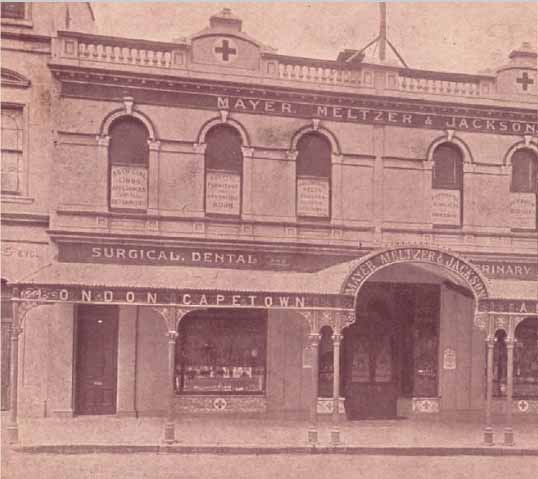|
Private Revenue Perfins of Victoria An Elsmore Coath production The authors would welcome your comments additions or input into this work A B C D E F G H I J K L M N O P Q R S T V W Y Other M -------------------------------------------------------- M.a
User: McPhersons Pty Ltd (Unconfirmed) Iron and Machinery merchants
Address: 554-566 Collins St, Warehouse (?) 582-592 Collins St, Showrooms Later (Circa 1940) 546 Collins St, (Associated Machine Tools) Melbourne, VIC Revenue Use: 1911 Series 1d, 6d Rarity Scale:
1911 Series 1d R4, 6d R4
Background: Thomas McPherson was born in Kingussie, Inverness, Scotland in 1822 and he emigrated to Melbourne, Australia arriving in 1852. He opened a business in Collins Street West, acting as a supplier of pig iron to the local foundry industry.
McPherson soon expanded the business to include supplying equipment, machinery and parts for workshops, machine tools, steam engines, and the like. By 1860, McPherson's business had evolved into a general hardware wholesaler and retailer. In that year, McPherson renamed his business as Thomas McPherson & Sons.
McPherson continued building the business and in 1881, his son Hunter McPherson, opened the company's first branch in Sydney.
Thomas McPherson died in 1888 and the business was taken over by Hunter McPherson and his brothers, including William (senior) father of William Murray McPherson, who would lead the company from 1929. The company continued to expand and in 1913 it was restructured as a proprietary company, McPherson's Pty. Ltd.
The company remained based in Victoria, but increasingly began to operate throughout Australia. By the 20th century, McPherson's had emerged as leading manufacturer and supplier of metal fasteners, fittings, and components and in this role they participated in a number of landmark public works projects, including the building of the Transcontinental Railway and the rivets for the Sydney Harbour Bridge.
William Murray McPherson took over as Governing Director in 1929 and he looked to develop Australian secondary industry and in doing so acquired Patience & Nicholson Ltd (1937), established Australian Abrasives Pty Ltd. and acquired Tool Equipment Co. Pty Ltd (1938) and formed a new company, Associated Machine Tools Australia Pty Ltd. as well as Ajax Bolt & Rivet Co. Pty Ltd (NZ) in 1939.
In December 1944 McPherson's converted to a public company, McPherson's Ltd, with William as Chairman of Directors.
McPherson's was an important contributor to the Australian war effort in World War II, but it soon expanded into the new fields of Printing and Homewares. This expansion was underpinned by key Company acquisitions including printers Hedges & Bell (1970), Dominion Press (1981), William Brooks & Co. (1982), Owen King Printers Pty. Ltd. (1988), Globe Press (1991), and Homewares brands Wiltshire File Company (1980), Strachan Silverware (1982).
Grosvenor and Rodd (1991) and later other brands including Staysharp, Deco, Ai-de-Chef, Kitchen Class, Richardson, and Gripi, among others.
The Printing and Homewares became the focus of the the company from the mid 1990’s when they sold off their manufacturing operations. This involved the acquisition of CPS Housewares Pty. Ltd. (1999), and later Crown Glassware (2000).
Device: The M.a device was a Single Die device and it was used between 1908 and 1919. It is a rather rough device when compared to the high quality devices sourced from England, so it may have been of local manufacture and indeed may have been made by McPhersons themselves.
The pattern is rarely found on the revenue stamps of Victoria but it is much more common on postage stamps of Victoria and later Australia.
Related Patterns: Refer to other McPhersons's and related company patterns in:
VIC: M.b, M.e, TMcP.a Device: Single Die Related Patterns: Nil -------------------------------------------------------- M.b
User: McPhersons Pty Ltd (Unconfirmed) Iron and Machinery merchants
Address: 554-566 Collins St, Warehouse (?) 582-592 Collins St, Showrooms Later (Circa 1940) 546 Collins St, (Associated Machine Tools) Melbourne, VIC Revenue Use: 1915 Series: 2d Rarity Scale:
1915 Series 2d R4
Background: See M.a
Device: Again, as with M.a, this is a rather rough pattern and it may have been produced on a temporary device by a stamp vendor. Also it may have been a device produced by McPhersons for their own use. It was a Single Die device and usage is limited to 1918.
Related Patterns: Refer to other McPhersons's and related company patterns in:
VIC: M.a, M.e, TMcP.a -------------------------------------------------------- M.c
User: James Moore & Sons Pty Ltd (Unconfirmed) Timber Merchants, Saw Millers & Importers Address: City Rd, South Melbourne, VIC Revenue Use: 1915 Series: 2d Rarity Scale:
1915 Series 2d R4
Background:
Device: The M.c pattern was most likely produced on a Single Die device and it is rare on both revenue and postage stamps.
The pattern is restricted to use in 1918 and such a limited usage period suggests that the pattern was either made on a Temporary device by a Stamp Vendor or made by a device that was only in service for a short period.
The pattern is not confirmed to this User (James Moore & Sons Pty Ltd) and it may be another example of a Temporary device produced by McPhersons, such as M.b.
Related Patterns: Refer to other James Moore & Sons company patterns in:
VIC: M.d -------------------------------------------------------- M.d
User: James Moore & Sons Pty Ltd Timber Merchants, Saw Millers & Importers Address: City Rd, South Melbourne, VIC Revenue Use: 1915 Series: 2d Rarity Scale:
1915 Series 2d R4
Background: See M.c
Device: Single Die
Related Patterns: Refer to other James Moore & Sons company patterns in:
VIC: M.c -------------------------------------------------------- M.e
User: Associated Machine Tools Australia Pty Ltd
Address: 546 Collins St, Melbourne, VIC A subsidiary of McPhersons's Pty Ltd User: McPhersons Pty Ltd Iron and Machinery merchants
Address: 554-566 Collins St, Warehouse (?) 582-592 Collins St, Showrooms Later (Circa 1940) 546 Collins St, (Associated Machine Tools) Melbourne, VIC Revenue Use: 1915 Series: 2d Rarity Scale:
1915 Series 2d R4
Background: See M.a
Device: Single Die
Related Patterns: Refer to other McPhersons's and related company patterns in:
VIC: M.a, M.b, TMcP.a. -------------------------------------------------------- MB.a
User: A D Meares and Bishop Stockbrokers
Address: 33 Bligh St, Sydney, NSW. Revenue Use: 1911 Series 6d, 9d, 1/-, 1/6d, 2/- 1915 Series 2d, 3d 1920-1966 Series (perf 11 issues) 2/6d, 3/-, 4/- 5/-, 6/-, 8/-, 10/- 15/-, £1, £2 1966 Series 1c, 2c, 3c, 4c, 5c, 8c, 10, 15c, 20c, 30c, 40c, 50c, 60c, 75c, $1, $1.75, $2, $5, $20 Rarity Scale:
1911 Series 6d R3, 9d R3, 1/- R3, 1/6d R4, 2/- R4
1915 Series 2d R4, 3d R4
1920-1966 Series 2/6d R4, 3/- R3, 4/- R3, 5/- R3, 6/- R4, 8/- R4, 10/- R2, 15/- R4, £1 R3 £2 R4
1966 Series 1c R1, 2c R3, 3c R4, 4c R2, 5c R2, 8c R3, 10c R1, 15c R4, 20c R2, 30c R3, 40c R2, 50c R1, 60c R3, 75c R2, $1 R1, $1.75 R4, $2 R1, $5 R4, $20 R4
Background: Alfred Meares was born in Sydney in November 1904 and in 1926 he became a clerk at the Sydney Stock Exchange. In 1932 he took a seat at the Sydney Exchange and worked for a small group of private clients.
After an absence for military service in World War 2 he returned to his seat and in 1949 he went into partnership with Jesse Bishop as A D Meares and Bishop.
Jesse Bishop had been born in Sydney in 1907 and was educated at Sydney University but completed his studies at Cambridge in England. Graduating in 1934 he worked for the Imperial Smelting Corporation for a short period before gaining a position with the stockbroking firm W Thompson and Son. and later Dormer Rumball and Co. in which he secured a partnership and a seat on the London Stock Exchange in 1940.
As with his future partner his career was punctuated by the war. After the war he worked in the legal department at Shell before returning to Australia for family reasons in 1948.
In 1949 he joined the Sydney Stock Exchange as a sole trader but soon joined fellow sole trader Meares.
The partnership soon moved from its small client base to become involved in some major share floats including Yates Seeds, Ampol Exploration, Canberra Television, J B Young and Thomas Nationwide Transport (TNT).
Bishop remained with the firm until 1965 and Meares retired from his role in the firm in 1970.
Device: The M&B pattern is found on the revenue stamps of New South Wales, Victoria and Tasmania as well as Western Australia. All of the strikes are identical and Meares and Bishop are not known to have had offices or seats on Stock Exchanges other than in Sydney. Given this it is reasonable to assume that the device was located in Sydney and applied to revenue stamps of various States as required to process transactions within the jurisdiction of a given State revenue office. This is supported by company stamps applied to documents that all show the Bligh Street, Sydney address.
Multiples of this pattern show an inconsistent relationship to each other so the device is most likely a single head one. This is supported by the fact that the strikes are identical which is less likely on a multiple die device, which often show variation between dies.
The M&B device is only found on revenue stamps and the use on documents shows that the stamps are punctured prior to being affixed indicating use as a security device rather than a cancelling device. The use as a security device to prevent theft is further supported by the fact that once affixed the stamps are then cancelled either by pen, company stamp or circular punch.
The device was used between 1962 and 1967.
Related Patterns: Refer to other usage of this A D Meares and Bishop device in:
NSW: M&B.a TAS: M&B.a WA: M&B.a -------------------------------------------------------- MBW.a
User: Melbourne & Metropolitan Board of Works Public Works Address: 110 Spencer St, Melbourne, VIC Revenue Use: 1915 Series: 2d 1930 Series: 3d Rarity Scale:
1915 Series 2d R4
1930 Series 3d R4
Background: *The Melbourne and Metropolitan Board of Works (M.M.B.W.) was a public utility established in 1891 in Melbourne to provide water supply, sewerage collection and treatment for the city. It was established under the Melbourne and Metropolitan Board of Works Act (1891) passed by the Victorian Parliament in December 1890.
The Board was designed along the London model, and there was no initial planning for a separate storm water management system. After increased urban development in the 1920s a need for improved metropolitan drainage (in particular drainage infrastructure involving more than one municipal district) was identified. Under the 1923 Metropolitan Drainage and Rivers Act the M.M.B.W. became responsible for metropolitan main drains, while Local Councils remained responsible for local drainage.
In 1949 the M.M.B.W. was authorized to prepare a comprehensive plan for Melbourne and the metropolitan area through an amendment to the 1944 Town and Country Planning Act, in 1954 the board was made the chief planning authority for metropolitan Melbourne, until these planning responsibilities were passed to the Ministry for Planning and Environment in 1985.
The responsibility for the construction and maintenance of metropolitan highways and bridges was vested in the Board by an amending Act in 1956, causing a great deal of conflict with the Country Roads Board (CRB) until all road responsibilities were passed to the CRB in 1974.
In 1992 the MMBW was abolished and replaced by Melbourne Water Corporation. During the 1990s Melbourne Water lost the majority of the former MMBW's remaining functions. It was split to form the 3 water retailers who became responsible from water supply and sewerage, while its waterway functions were transferred firstly to Melbourne Parks and Waterways and then to Parks Victoria. Device: The MMBW were consistent users of security devices to avoid the theft of revenue, an indeed postage stamps.
The first step was to use Temporary patterns available from the stamps vendors in Melbourne. This is limited to 1894 because in 1895 they acquired there first MMBW perforating device. This and the Temporary pattern are not reported on revenues stamps but the next MMBW device (MMBW.a) purchased in 1904 is. This device was used between 1904 and 1928 and it overlaps with other MMBW devices including MMBW.b, as follows:
MMBW Temporary patterns 1894 MMBW first customised device 1895 – 1920 MMBW.a 1904-1928 MMBW.b 1914-1930
All of these devices were single die devices and they seem to have been in high demand with generally two and at times three devices available in the Companies office at the same time.
The security focus seemed to be on combined postage/revenue stamps prior to 1901 and this moved to both of the separate postage and revenue issues from 1901, but interestingly the focus then moved to just revenue stamps as after Circa 1930 the Company moved to security pre cancels on their revenue stamps and this practise persisted until the early 1980’s
Related Patterns: Refer to other Melbourne & Metropolitan Board of Works company patterns in:
VIC: MBW.b
Other Section 2 Commercial Overprints
M.M.B.W..a .b .c .d .e .f .g .h
*Wikipedia, Trove -------------------------------------------------------- MBW.b
User: Melbourne & Metropolitan Board of Works Public Works Address: 110 Spencer St, Melbourne, VIC Revenue Use: 1915 Series: 2d Rarity Scale:
1915 Series 2d R4
Background: See MMBW.a
Device: See MMBW.a
Related Patterns: Refer to other Melbourne & Metropolitan Board of Works company patterns in:
VIC: MBW.b
Other Section 2 Commercial Overprints
M.M.B.W..a .b .c .d .e .f .g .h -------------------------------------------------------- MC.a
User: Unknown Address: Melbourne, VIC Revenue Use: 1915 Series: 2d Rarity Scale:
1915 Series 2d R4 Background: Device: The MC.a pattern is made from a temporary die in a single die format as made up by Stamp Vendors. This is a very rare pattern on both postage and revenue stamps.
The pattern is reported in a very narrow usage around 1915 and the user is unknown. There are 3 CM patterns known, all rare, but this is the only one found on revenue stamps. All usage is in Melbourne.
It is a very similar pattern to a series of CM patterns that are found on postage stamps of Victoria in the period 1911 until 1918, also only in Melbourne. It is possible that it is a incorrect setting of CM that creates the MC pattern. Regrettably the user of the CM pattern is also unknown. Related Patterns: Nil -------------------------------------------------------- MC/B.a
User: McCracken's City Brewery(unconfirmed) Address: 527 Little Collins St, & 518 Collins St, Melbourne, VIC Revenue Use: 1886-1899 Series, inscribed 'STAMP DUTY' 1d (shades) Rarity Scale:
1886-1899 Series 1d R4
Background: *The City Brewery operating as Robinson & McCracken was first established in 1850 in a small stone structure at 527 Little Collins Street. Initial capacity was 8 hogsheads (2618 litres) at a single brew. It was one of four breweries in Melbourne. The association between Robert McCracken and Thomas Robinson lasted until early 1859 when McCracken continued the business alone, under the name of R. McCracken & Co.
Soon after the establishment of the brewery, an excise of 12 shillings and 8 pence per hogshead was put on beer.
Like most breweries, the company owned a chain of hotels, including the Stork Hotel (façade surviving) in Elizabeth Street and Governor Arthur Hotel (demolished), “one of the oldest in Melbourne”, in Little Bourke Street West.
McCracken’s City Brewery was “one of the most important establishments of the kind in the colony (of Victoria)” in 1883, when major extensions were made to the brewery. Designed by leading architects Reed, Henderson and Smart in modern classical style, the work cost £12,000 and created an impressive four storey frontage on Collins Street of 113 feet (34m.).
The Collins Street end, with its central feature of the brewery’s arms, contained offices while the Little Collins Street end housed the brewery and stabling for 28 horses. About 100 workers were employed. Demand for beer exceeded production capacity despite the new ability to brew 340 hogsheads (81,083 litres) from one brewing. The annual quantity of beer brewed was 3 thousand gallons.
Breweries started selling bottled beer around 1884 and by 1885 City Brewery made further extensive additions “to meet the requirements of their growing trade”. McCracken’s City Brewery included Peter, Alexander, Thomas and Coiler McCracken among the management. (In 1888, Coiler McCracken would build Earlsbrae in Essendon, which became Lowther Hall Anglican Grammar School in 1919.)
In 1888 McCracken’s City Brewery was purchased by a syndicate who issued a prospectus to float the business as a public company, “the largest joint stock brewery in Australia”. In November, City Brewery raised £500,000 in debentures to purchase hotels and acquire 15 acres of land in Bridge Road, Richmond, in order to build a new brewery “further out of town” and sell the Collins Street asset. (It was demolished in 1909.)
In 1900, the company made a loss and McCracken’s had difficulty meeting its debenture payments; blamed on poor quality beer, the problems were however deeper. Breweries faced rising costs and oversupply as well as fierce competition for ‘tied’ hotels and their trade.
By 1906, negotiations were underway to form a consortium of breweries involving Carlton, Victoria, Foster’s, McCracken’s, Shamrock and Castlemaine breweries under Carlton Consolidated Breweries Pty Ltd (now Carlton & United Breweries). Only Carlton, Victoria and Foster’s breweries would remain in production.
In December, 1907 McCracken’s City Brewery ceased to exist and became merely a holding company in the new entity.
Device: The M/CB.a is one of approximately 24 MCB patterns that are either confirmed or provisionally assigned to McCracken's City Brewery.
All of these patterns are made from a temporary die in a single die format as made up by Stamp Vendors. These Temporary patterns date from 1898 until at least 1904 and this is consistent with the company history of McCracken's City Brewery.
The M/CB.a pattern is rare on both postage and revenue stamps and its specific usage is limited to the period around 1897-1903.
Related Patterns: Nil
*Jenny O’Donnell research, Trove, State Library of Victoria -------------------------------------------------------- M/CB.b
User: McCracken's City Brewery(unconfirmed) Address: 527 Little Collins St, & 518 Collins St, Melbourne, VIC Revenue Use: 1886-1899 Series, inscribed 'STAMP DUTY' 1d (shades) Rarity Scale:
1886-1899 Series 1d R4
Background: See M/CB.a above
Device: The MC/B.a is one of approximately 24 MCB patterns that are either confirmed or provisionally assigned to McCracken's City Brewery.
All of these patterns are made from a temporary die in a single die format as made up by Stamp Vendors. These Temporary patterns date from 1898 until at least 1904 and this is consistent with the company history of McCracken's City Brewery.
The MC/B.a pattern is rare on both postage and revenue stamps and its specific usage is limited to the period around 1902.
Related Patterns: See M/CB.a above -------------------------------------------------------- MCC.a
User: Melbourne City Council Address: Swanston St, Melbourne, VIC Revenue Use: 1911 Series 1d Rarity Scale:
1911 Series 1d R4
Background: *Melbourne was founded in 1835, following the arrival of the schooner “Enterprise” with settlers from Tasmania and the speculative settlement that followed, on land that was actually part of New South Wales.
Initially the settlement was managed as a province of New South Wales but with the growth of the settlement there had been an increasing demand by the inhabitants for greater autonomy over their own affairs. On 12 August 1842, Melbourne was incorporated as a “town” by Act 6 Victoria No. 7 of the Governor and Legislative Council of New South Wales.
The town of Melbourne was raised to the status of a “city” by Letters Patent of Queen Victoria dated 25 June 1847, five years after its incorporation as a town. On 3 August 1849, Act 13 Victoria No. 14 established the boundaries of the city to be much of what was to become the inner metropolitan area. However during the rapid growth of the city during the 1850s, many of the surrounding inner suburbs, such as Collingwood, Fitzroy, Richmond, St Kilda, South Melbourne and others, seceded from Melbourne and this served to narrow the boundaries of the city.
On 18 December 1902, King Edward VII conferred the title "Lord Mayor" on the mayor of the City of Melbourne and on 30 October 1905, Melbourne absorbed two neighbouring council areas.
The city then included Flemington, Kensington, North Melbourne, Carlton, and later, Southbank, Port Melbourne, Fishermans Bend, Parkville, South Yarra and most recently Docklands.
Device: The MCC.a device is a single die device and this is proved by examples of multiple strikes that show no consistent relationship to each other. It came into service in 1902 and was used continuously until at least 1918.
It is most often found on the postage stamps of Victoria and later Australia (from 1913). It is much rarer on revenues.
The device appears to have been a reliable one and it consistently produced clear strikes of the MCC pattern.
Related Patterns: Nil
*Wikipedia, Trove -------------------------------------------------------- McK/& C.a
User: James F McKenzie & Co Pty Ltd Tea & Coffee Merchants, later General Merchants
Address: Initially 35 Lygon St, Carlton, VIC From 1872, 3 Queen St (Factory), Melbourne, VIC 6 Queens St (Office), Melbourne, VIC 5-9 Bond Street, Melbourne, VIC From circa 1915, 348 Flinders St, Melbourne, VIC
Revenue Use: 1915 issue 3d(Roulette) Rarity Scale:
1915 issue 3d(roulette) R4
Background: *In 1852, William Galt and James F. McKenzie established Melbourne Grinding and Roasting Mills at 35 Lygon Street, Carlton, the partnership ceasing in 1857 when Galt retired.
The business, now styled James F. McKenzie & Co., continued at the same address with McKenzie living at no. 37 Lygon Street.
By 1858, the firm was specialising in foodstuffs such as tea, coffee, flour, oats, bran and spices with premises in Queens Street, with mills at the rear of the offices in Bond Street.
By 1872, James F. McKenzie’s name had ceased to appear as a manager, instead being replaced by William Peterson and John S. Peterson (among others including John Whiting and A.M. Whiting) listed as general merchants at the same Bond Street address as James F. McKenzie. (refer perfin WP/& Co.)
At the Intercolonial Exhibition of 1875, J.F. McKenzie & Co had two well arranged stalls exhibiting coffee and spices of all descriptions on one, and oatmeal, peasmeal, mustard, maizemeal, groats and cocoa on the other. These were all prepared at the four storey brick mills of the company at 5-9 Bond Street, 40 people being employed in the various processes. Cocoa and chocolate were made from raw beans, while mustard was locally grown in the colony.
In 1888, James F. McKenzie would be praised for having introduced and acclimatised several industries to the colony; his local sourcing of oats being credited with reducing the high cost of oatmeal.
In 1915 James F McKenzie & Co became a public company as James F. McKenzie Pty Ltd and around this time they moved to premises at 348 Flinders St, Melbourne.
In 1852, William and Francis Ward had established a hay and corn store in King Street, Melbourne. In 1967, Ward’s acquired James F. McKenzie Pty Ltd, and the new entity commenced trading as Ward, McKenzie Pty Ltd under which style it continues to the present day.
Device: The McK/&C.a pattern was a Temporary perfin pattern made by a Stamp Vendor. These patterns were produced by single die devices that could be set up to produce various letter combinations.
The McK/&C.a pattern is found used on the revenue stamps of Victoria and the postage stamps of Australia in a very narrow period around 1930. This narrow band of use, the rarity of the pattern and its consistency all suggest that the pattern was the result of a single setting of the Temporary die.
The Company had their own perforator McK/&Co.a but it may have been out of service and hence the use of a Temporary pattern.
Related Patterns: Refer to other James F McKenzie & Co Pty Ltd and related company patterns in:
VIC: MC/K&Co.a & P/&Co.a
*Jenny O’Donnell research, Trove, State Library of Victoria -------------------------------------------------------- McK/& Co.a
User: James F McKenzie & Co Pty Ltd Tea & Coffee Merchants Address: 3 Queen St (Factory) 6 Queens St (Office) From circa 1915, 348 Flinders St, Melbourne, VIC Revenue Use: 1915 issue 2d Rarity Scale:
1915 issue 2d R4
Background: See McK/& C.a
Device: The McK/&Co.a Pattern/device is one of the most interesting ones in the study of Australian private perfins.
The structure of this single die device is very similar to the temporary dies used by stamp vendors, but unlike these patterns it remains consistent in its layout and separation between letters over its long usage period of 1894-1946. Now this similarity may just be coincidental but it could also be that the company purchased a device similar to those used by stamp vendors and then used it with a single setting over the entirety of the usage period. This is logical as they would have had no need to vary the layout as the company name remained the same.
In South Pacific Perfin Bulletin (SPPB) # 95 of October 2011, David Coath wrote an article on the IHC.3 pattern listed in previous perfin studies, in which he made the case that this device used in the Melbourne office of International Harvester was a consistent setting of a temporary device.
Whatever the nature of the device that produced the McK/&Co.a it was a sound one and it produced generally consistent patterns over its long lifespan.
In about 1927 the pattern begins to become less clear, initially with the loss of pins on the right hand side of the pattern, including the “O” of the “CO”. This lead other Perfin studies to report a pattern McK/&C which was identical to McK/&Co.a but without an “O”. This report is false as the loss of the “O” is just part of the progressive degradation of the device which is shown in the image below.
The McK/&Co.a pattern is found very rarely on the revenue stamps of Victoria but it is very common on the postage stamps of Victoria and Australia.
Related Patterns: Refer to other James F McKenzie & Co Pty Ltd and related company patterns in:
VIC: MC/K&C.a & P/&Co.a Peterson Invoice using McKenzie Perfin ------------------------------------------------------- McL/McK.a
User: McLean, McKenzie & Co Stock/Station Agents Address: 443 Bourke St, Melbourne, VIC Revenue Use: 1925 Stamp Duty Series (O'printed CATTLE) 2/6d, 3/-, 4/-, 5/-, 15/- 1937 Numeral Series (O'printed CATTLE) 3d, 6d, 1/- Rarity Scale:
1925 Series 2/6d R4, 3/- R4, 4/- R4, 5/- R4, 15/- R4
1937 Series 3d R3, 6d R4, 1/- R4 Background: *Allan McLean was born in February, 1840 in Oban, Scotland, migrating with his parents, Charles and Anne, and uncle, Angus, to Sydney, where his father was offered management of (police) Captain Lachlan MacAlister’s sheep runs near the Avon River in newly discovered Gippsland. By 1848, the McLean brothers, together with Simon Gillies had established their own Glenaladale station on the Mitchell River. McLean was educated at home and at Tarraville school, graduating to adult life as an all-round bushman, who could also sing, dance and write poetry. In 1865, McLean and his brother Norman took up the lease on Lowlands Station, near Sale, and in 1872, he formed A. McLean & Co. stock and station agents of Maffra, in which his brother joined him. The success of the enterprise was largely founded on McLean’s reputation as an auctioneer. By 1907, there were also branches in Traralgon and Bairnsdale, and later in Warragul and Mirboo. In early 1914, McLean, M(a)cAlister & Co. are found at Salisbury Buildings, Melbourne. NOTE: Lachlan MacAlister died 1855, which of his relatives was involved in the company is not known. In October, 1916, McLean, McKenzie Macalister “fat stock salesmen” were conducting weekly sales at Newmarket. The auctioneers were W.J. McLean, and Hector McKenzie, son of Hugh McKenzie. McLean, McKenzie Macalister was “associated with McLean & Co. (of) Sale, Bairnsdale. Maffra, Traralgon, Morwell and Warragul;” and “McKenzie & Co. (of) Echuca, Deniliquin, Kyabram, Finley, and Mathoura”. In December, 1916, McLean, McKenzie Macalister & Co.is listed as a member of the Association of Stock and Station Agents, of Melbourne. By March, 1917, MacAlister had left the business which became McLean McKenzie & Co., stock and station agents, Salisbury Buildings, 443 Bourke Street, Melbourne “one of Australia’s leading agents”. In late 1950, Australian, Mercantile, Land and Finance Company Limited (Incorp. In England) announced that arrangements had been completed for the merger into the company of the three associated “old established” Stock and Station businesses, those of McLean McKenzie & Co., Melbourne, A. McLean & Co. Pty Ltd and McLean & Hill Pty Ltd. Allan and Bruce McLean, grandsons of Allan McLean, and Hugh A McKenzie joined the new entity, while the advice of Hector T. McKenzie was available.
Allan McLean In 1873, a year after establishing McLean & Co., Allan McLean became a councillor for Avon Shire, and was three times shire President. McLean was elected to the Legislative Assembly for Gippsland North in May, 1880, and was President of the Board of Lands and Works, Commissioner of Crown Lands and Survey, and (briefly) Minister of Agriculture from 1890-91. In November 1899, he became Premier and Chief Secretary until November 1900. (In 1911, his portrait was hung in Victoria’s Parliament House.) In March 1901, McLean entered the new Federal Parliament as the House of Representatives member for Gippsland. He became Minister for Trade and Customs and deputy to Reid, the Prime Minister. McLean was not returned in the 1906 election and died at his Albert Park home in December 1906, aged 66. He is buried in Sale cemetery. In April 1938, William Joseph McLean, eldest son of Allan McLean, died at his Toorak home. After leaving school, William entered his father’s firm of A. McLean & Co. of Maffra and remained an active partner until his death. William McLean was also a member of the associated firm of McLean, McKenzie & Co., Melbourne. Two of William’s sons, Allan and Bruce followed him into the business.
Hugh McKenzie Hugh McKenzie was born in Sutherlandshire, Scotland in 1853, arriving in Portland Bay in 1857. His father became manager on Glencoe Station, Mt Gambier, before moving to Sir James McBain’s Wyuna Station, near Murchison, in 1865. On leaving school, McKenzie joined his father as overseer on Wyuna. With Lawrence Kickham, he established a successful general store at Undera before becoming a mail contractor. In 1887, he joined J.M. Chanter (MLA New South Wales) in a stock and station agency, with branches in Echuca, Kyabram, Jerilderie and Moama. The business was merged with the Murray River Stock and Station Agency in 1889, which was forced into liquidation in 1892. McKenzie formed a partnership with Echuca auctioneer Thomas Copp and in 1894 established McKenzie & Co, stock and station agents, with branches at Echuca, Kyabram, Jerilderie and Deniliquin. McKenzie & Co. was carried on by Hugh McKenzie and two of his sons (Hector and Hugh) until its acquisition by Younghusband Ltd in 1929. Hugh McKenzie joined the Echuca Borough Council in 1882, serving as a councillor for 14 years, and mayor for two terms. In 1904 he was elected to the Legislative Assembly for Rodney and remained a member until his defeat in 1917. McKenzie was President of the Board of Lands and Works, Commissioner of Crown Lands under two governments, Minister of Railways and of Water Supply, and Vice-President of the Board of Lands and Works 1915-17. McKenzie was important in developing the closer settlement policy, which saw the break-up of the vast pastoral estates. His community involvement included Captain in the Victorian Rangers, membership of the Farmers & Citizens Trustee Co., Bendigo; the Echuca Agricultural Society, the board of management of Echuca Technical College Council. McKenzie founded the Echuca branch of the Australian Natives Association in 1886, and was president of the Echuca Hospital Board. Hugh McKenzie died in Echuca, aged 88, in August, 1942. Device: The McL/McK.a pattern is made from a permanent customised device in a single die format. The device was only in service for a short period of time between 1934 – 1938 (?) and to date the pattern has only been found on the revenue stamps of Victoria.
The pattern is only found on revenue stamps overprinted “Cattle” and it may have been sourced for this specific application.
Related Patterns: Nil
*Trove nla.gov.au *Rickard, John. ‘Allen McLean 1840-1911’, Australian Dictionary of Biography. *Rolfe, A. ‘Hugh McKenzie 1853-1942’, Australian Dictionary of Biography. *parliament.vic.gov.au/re-member/details/561-mclean-allan *parliament.vic.gov.au/re-member/details/1286-mckenzie-hugh *Wikipedia. *State Library of Victoria. -------------------------------------------------------- MH.a
User: Massey-Harris Co Ltd Agricultural Machinery Address: 570-576 Bourke St, Melbourne, VIC Revenue Use: 1911 Series 1d Rarity Scale:
1911 Series 1d R4
Background: *The company that was later to be known as Massey Harris, was founded in 1847 in Newcastle, Ontario, Canada by Daniel Massey as was initially known as the Newcastle Foundry and Machine Manufactory. The company made some of the world's first mechanical threshers, which could thresh (effectively thrash) wheat to separate the grain form the stalks and husks.
The company was expanded by Daniel’s son Hart and in 1879 it moved its headquarters to Toronto where it was renamed the Massey Manufacturing Co. In 1891 the company merged with A Harris, Son & Co Ltd to become Massey-Harris Company Limited and the largest agricultural equipment manufacturer in the British Empire
In 1910, the company acquired the Johnston Harvester Company located in Batavia, New York, making it one of Canada's first multinational firms. The company then embarked on the production of a range of tractors in addition to their core business of building threshers.
In 1930 the company expanded into Australia where it awarded the H.V. McKay Company exclusive Australian distribution of Massey-Harris machinery. Hugh Victor McKay had invented the stripper harvester in 1884, the first machine to combine the functions of reaping, threshing and winnowing grain from a standing crop.
McKay later established a manufacturing base at Ballarat, and then transferred to Braybrook Junction, where he took over the Braybrook Implement Company Works and renamed it Sunshine Harvester works. By the 1920s the H.V. McKay Company was running the largest implement factory in the southern hemisphere, covering 30.4 hectares (75 acres), and were leading the international agricultural industry through the development of the world's first self-propelled harvester in 1924.
The company was then renamed H.V. McKay Massey Harris Pty Ltd. In 1953, the parent company merged with the Ferguson Company to become Massey-Harris-Ferguson, and in 1955, they acquired their Australian partner the H.V. McKay Company. In 1958 the company changed its name to Massey Ferguson. Device: Device: Massey-Harris Co Ltd were major perfin users and there are more than 50 different patterns proven or provisionally attributed to them with usage spanning the period 1899 until at least the mid 1920’s. These are all reported on postage stamps and usage on revenue stamps is very rare with only a handful of reports recorded. All of these were used in Melbourne which suggests that they were used at the Companies head office in Melbourne and not at the companies suburban manufacturing facilities. Some early examples carry Tasmanian postmarks, but these are receiving marks which was a common practice for cancelling mail bound for Tasmania. Further all were Temporary Punctures, that is patterns created by temporary dies created to apply a pattern to a stamp purchased from a stamp vendor. MH.a is found in about 7 different types on postage stamps with varying separation of the letters M and H, but the only type reported on revenues is a rather wide separation of the letters. Note that the M has some missing pins, this is not uncommon in temporary dies patterns, as the settings were made up each time they were required and as a result they are not always the same or indeed as complete.
MH.a is found used over the period 1899 until at least 1915. Early use of this setting is rare and it is most commonly found in the period 1910-1915.
Related Patterns: Refer to other Massey Harris and related company patterns in:
VIC: MH.b
*Wikipedia ------------------------------------------------------- MH.b
User: Massey-Harris Co Ltd Agricultural Machinery Address: 570-576 Bourke St, Melbourne, VIC Revenue Use: 1911 Series 6d Rarity Scale:
1911 Series 6d R4
Background: See MH.a
Device: See MH.a above.
MH.b is found in only a single setting on postage and revenue stamps, which is an amazing coincidence as the pattern is found over the period 1903 until 1915 with specific settings know to have been produced in 1903, 07, 08 and 15.
It is scarce pattern, even on postage stamps and the usage on revenue stamps is limited to a single report.
Related Patterns: Refer to other Massey Harris and related company patterns in:
VIC: MH.a -------------------------------------------------------- MH/C.a
User: Michaelis, Hallenstrin & Co Pty Ltd Tanners Address: 30 Lonsdale St East, Melbourne, VIC Revenue Use: 1902 Series 1d Rarity Scale:
1902 Series 1d R4
Background: *Moritz Michaelis (1820-1902), was born on 8 November 1820 at Lügde, near Bad Pyrmont, Hanover, son of Reuben Michaelis and his wife Sara. His parents, though financially struggling, sent him to a private school and in 1835 to Holzminden to study medicine. After a brilliant year the money ran out and he had to begin a four year apprenticeship with a Brakel firm. He then worked for a Cologne linen merchant and was soon manager.
In 1843 he joined a Manchester firm, Sampson & Leppoc, and won rapid promotion, but his health was poor due to the conditions in Manchester. So the firm decided to send Michaelis and Adolphus Boyd to Victoria. On a farewell visit to Germany Michaelis met Rahel Gotthelf, daughter of his sister's husband. They married on 14 April 1853 and in August arrived at Port Phillip in the Falcon.
Michaelis and Boyd began business in Richmond but in 1855 they left Sampson & Leppoc, moved to Collins Street and with a capital of £15,000 drew up a five year partnership agreement. Boyd returned to England to manage the buying and shipment of goods and the firm prospered; in 1860 the agreement was renewed.
In 1864 Michaelis visited Europe but on his return he faced ruin. The end of the American civil war lowered the price of key goods in their inventory and in May 1866 the partners' creditors accepted a composition of 14s. in the £ and in March 1867 the partnership was dissolved.
Michaelis had already joined his nephew, Isaac Hallenstein, who in 1864 had bought a tannery at Footscray. Michaelis, Hallenstein & Co. grew rapidly; in 1873 Isaac established a London branch and in Melbourne 780 hides were turned out a week; in 1876 the Sydney branch, Farleigh, Nettheim & Co., (see F section in the NSW Chapter) started and in 1879 Michaelis, Hallenstein & Farquhar was established in New Zealand.
In 1892 the Footscray Tannery was extended and the firm’s warehousing and administrative activities were handled from 30 Lonsdale St East, 23-27 Lonsdale St West and 382-384 Lonsdale St successively. After WW1 new dedicated premises were built at 441-445 Lonsdale St.
During WW1 the company was forced to move from exports, which had been its mainstay, to local manufacturing and this included becoming a major supplier to the AIF through a subsidiary known as Associated Leathers. After the war the company returned to export but also served the local market with expansion into glue, gelatine, sporting goods and material for the growing automobile industry.
With the arrival of WW2 the company expanded into canvas goods, tents and haversacks for the military but after the war this turned to the needs of the domestic market including tents, tarps., shoe repair goods, toys, sporting goods, furniture and travel goods.
The company continued to grow through acquisitions of related companies and agents in other States so that the company was a truly Australia wide entity.
In 1962 the company moved out of the CBD and concentrated their operations at dedicated premises at 150 Buckhurst St, South Melbourne.
Device: The company of Michaelis, Hallenstein & Co Pty Ltd where significant perfin users over the period from at least 1895 until at least 1913.
The MH/C.a pattern is only one of a myriad of patterns that the company sourced as temporary dies in a single die format, as made up by Stamp Vendors.
These came in various formats including MH/C (3) MH/&C (12) MH/&CO (16) and MH/ACO/LTD (4) that are either proved, or provisionally assigned to Michaelis, Hallenstein & Co Pty Ltd.
These Temporary patterns have overlapping usage periods and are most commonly found on the postage stamps of Victoria and rarely the postage stamps of Australia. Only a handful are reported on revenue stamps and these are listed in this chapter as follows:
MH/C.a 1896 - 1913 MH/&C.a 1907 - 1913 MH/&Co.a 1895 - 1898 MH/&Co.b 1899 - 1907 MH/&Co/LTD.a 1896
As always with these Temporary patterns there is frequently variation in the settings for each pattern with differences in layout and separation between letters. Some of this variation is reported on revenue stamps but only rarely, due to the relative rarity of revenue use compared with postal use.e.
Related Patterns: Refer to other Michaelis, Hallenstein & Co Pty Ltd and related company patterns in:
VIC: MH/&C.a MH/&Co.a MH/&Co.b MH/&Co.c MH/&Co/LTD.a
NSW: FNCo.a
*Australian Dictionary of Biography “The Michaelis, Hallenstein Story 1864-1964 - One Hundred Years in Leather” *Jenny O’Donnell research, Trove, State Library of Victoria -------------------------------------------------------- MH/&C.a
User: Michaelis, Hallenstrin & Co Pty Ltd Tanners Address: 30 Lonsdale St East, Melbourne, VIC Revenue Use: 1902 Series 6d Rarity Scale:
1902 Series 6d R4
Background: See MH/C.a
Device: See MH/C.a
Related Patterns: Refer to other Michaelis, Hallenstein & Co Pty Ltd and related company patterns in:
VIC: MH/C.a MH/&Co.a MH/&Co.b MH/&Co/LTD.a
NSW: FNCo.a -------------------------------------------------------- MH/&Co.a
User: Michaelis, Hallenstrin & Co Pty Ltd Tanners Address: 30 Lonsdale St East, Melbourne, VIC Revenue Use: 1886-1899 Series, inscribed 'STAMP DUTY' 1d (shades) 6d Rarity Scale:
1886-1899 Series 1d R3, 6d R4
Background: See MH/C.a
Device: See MH/C.a
Related Patterns: Refer to other Michaelis, Hallenstein & Co Pty Ltd and related company patterns in:
VIC: MH/C.a MH/&C.a MH/Co.b MH/&Co/LTD.a
NSW: FNCo.a -------------------------------------------------------- MH/&Co.b
User: Michaelis, Hallenstrin & Co Pty Ltd Tanners Address: 30 Lonsdale St East, Melbourne, VIC Revenue Use: 1885 Stamp Duty Series 2/6d Rarity Scale:
1885 Stamp Duty Series 2/6d R4
Background: See MH/C.a
Device: See MH/C.a
Related Patterns: Refer to other Michaelis, Hallenstein & Co Pty Ltd and related company patterns in:
VIC: MH/C.a MH/&C.a MH/&Co.a MH/&Co/LTD.a
NSW: FNCo.a -------------------------------------------------------- MH/&Co/LTD.a
User: Michaelis, Hallenstrin & Co Pty Ltd (Unconfirmed) Tanners Address: 30 Lonsdale St East, Melbourne, VIC Revenue Use: 1886-1899 Series, inscribed 'STAMP DUTY' 1d Rarity Scale:
1886-1899 Series 1d R4
Background: See MH/C.a
Device: See MH/C.a
Related Patterns: Refer to other Michaelis, Hallenstein & Co Pty Ltd and related company patterns in:
VIC: MH/C.a MH/&C.a MH/&Co.a MH/&Co.b
NSW: FNCo.a -------------------------------------------------------- MM.a
User: Morris Meeks & Co Iron Merchants and Agricultural equipment
Address: 370-372 Little Collins St, Melbourne, VIC Revenue Use: 1886-1899 Series, inscribed 'STAMP DUTY' 1d (shades) Rarity Scale:
1886-1899 Series 1d R4
Background: *John Morris was born in Padbury, England, in 1832, and migrated in the early 1840s to South Australia. In July, 1902, John Morris, described as “iron merchant” died at the age of 73 at his home in Orrong Road, Elsternwick.
In 1864, Morris appears as a warehouseman at 84 Queen Street, Melbourne, residing in Northcote. The following year, John Morris and F.S. Roberts are commission agents at 21 Little Flinders Street West. The business became John Morris & Co. in 1867, commission agents, soft goods broker, insurance surveyor, agents for Geelong Woollen Co. (1869), and agents for England and Australia Copper Co.
The business became Roberts, Morris and Deakin (Charles) iron and general merchants of 55-57 Flinders St. East, in 1878. By 1880, the firm had offices at 76 Lt. Flinders St., and premises at 41 King St, 66-76 Little Flinders St, and 53-55 Flinders St.
The partnership with Charles Deakin was short lived as he died in 1881. By 1882, F.S. Roberts had retired to his country property.
The business became Morris, Roberts and Meeks in October, 1884, when John Morris of “Carron Iron Yard, Flinders Street East” admitted William Henry Roberts and Henry Meeks into partnership. Both men were formerly connected with Briscoe & Co (iron merchants of Melbourne, “Wolverhampton and Sydney” and agents for Hornsby agricultural machinery).
The Morris family involvement included James Jackson Morris, who would later head the firm, and Maesmore (an accountant). By the 1890s, Maesmore had become an abusive drunkard, so violent that his wife’s father had ordered her to leave her husband, while her father-in-law took charge of the only son of the marriage.
Maesmore fled to South Africa and by 1905 was living under the alias ‘Steve’. He was disowned by the family.
In the same year as the partnership was formed (1884), Morris, Roberts & Meeks commissioned architects Anderson, Twentyman and Askew to design a new warehouse in Little Collins Street. The business continued to operate out of Carron Iron Yard selling a huge range of heavy agricultural machinery, drilling machines and steam hammers. The company remained Victorian agents for England and Australia Copper Co.
In 1889, W.H. Roberts retired and James Jackson Morris, son of John Morris, became a partner with Henry Meeks, the firm now being styled Morris & Meeks.
By the early 1900s, Morris & Meeks was advertising as Melbourne agent for Nobel’s Hamburg Dynamite Co., in 1901, receiving permission from Beechworth Council to erect a building, “well out of town”, for the storage of detonators. The following year, they received a permit from Bright Shire Council to erect a powder magazine in Baker’s Gully Road, Bright. In the same period, the company was receiving significant orders for grindstones, general ironmongery, and builders’ ironmongery from the nascent Victorian Railways Commission.
William Henry Roberts died at his home in Brighton, in 1905, at the age of 86. Morris Meeks & Co finally “closed its doors” in late 1919. In January 1920, James Jackson Morris “until recently head of Morris Meeks & Co hardware merchants of Collins Street, Melbourne”, was thrown from his motor vehicle and killed.
Henry Meeks was born in 1841 in Cheltenham, England, where his father was a bootmaker. He arrived as a boy in Victoria in 1851 and had a number of short-term jobs to a clothes dealer, a draper, and then a saddler before joining Fulton’s Foundry. In 1865, he joined Briscoe & Co. Ltd hardware merchants, before joining John Morris and J.S. Roberts in the firm Morris, Roberts & Meeks (1884).
During 60 years in business, “he found time to devote himself to many affairs of public and semi-public character” being “a corner stone in the Temperance and Life Assurance Society”. A leading member of the Rechabite Order and a central figure in the Collins Street Baptist Church; for thirty years, he was also chairman of the Australasian Temperance and General Society.
Henry Meeks became a director of the Victorian Permanent Building Society, was twice vice president of the Chamber of Commerce and one of its representatives at the Chambers of Commerce world congress in London. He was one of the founders and first chairman of the Victorian Importers’ Association and was appointed (1914) a Commissioner of the Melbourne Harbour Trust, soon after becoming chairman. For 60 years in the hardware trade he was considered “a big and effective gun – and regarded as president in perpetuity of the Hardware Association.
To honour his approaching 76th birthday in 1917, a group of men, all in competition with Morris Meeks & Co., met to consider some form of recognition of Meeks’ services to the hardware trade. The result was the Henry Meeks Pavilion (a combination of surgery, operating theatre and pathology laboratory) at the Austin Hospital.
Henry Meeks died at his Auburn home in August 1922, a few days after his 81st birthday. He left 3 daughters and 3 sons – Major Meeks of Albany, W.A., W. Meeks of Perth, and J. Meeks, chairman of Harrison Ramsay Ltd, Sydney. A brother, Alfred Meeks, was chairman of the Australian Mutual Provident Society.
Device: The MM.a pattern is made from a temporary die in a single die format as made up by Stamp Vendors. This is one of 2 different MM patterns that have recently been proved to Morris & Meeks through revenue usage, see image for MM.b. The pattern as previously thought to be used my Mercantile Mutual, see MM.c.
These Temporary MM patterns are peculiar as they do not have the overlapping usage common to Temporary dies, with usage as follows:
MM.a 1895-1900 MM.b 1900-1918
These patterns are relatively common on postage stamps but they much scarcer on revenue stamps.
Being a simple pattern with just 2 letters there is little variation with the exception of the spacing between the M’s and some misplaced pins.
Related Patterns: Refer to other Morris & Meeks company patterns in:
VIC: MM.b
*Jenny O’Donnell research, Trove, State Library of Victoria -------------------------------------------------------- MM.b
User: Morris Meeks & Co Iron Merchants and Agricultural equipment
Address: 370-372 Little Collins St, Melbourne, VIC Revenue Use: 1911
Series 1d 1918 Series 1d Rarity Scale:
1911
Series 1d R4
1918
Series 1d R4 Background: See MM.a
Device: See MM.a
Related Patterns: Refer to other Morris & Meeks company patterns in:
VIC: MM.a -------------------------------------------------------- MM.c
User: Merchantile Mutual Insurance Address: 108-118 Queen Street, Melbourne, VIC Revenue Use: 1915 Series: 2d Rarity Scale:
1915 Series 2d R4
Background: *Mercantile Mutual was established in Sydney in 1878. The idea to establish a distinctly Australian insurance company had been discussed amongst a group of Sydney businessman in the previous year while they were attending the cricket match to decide the team to travel to England for the first Test series
The company grew quickly reflecting the booming Colonial economies of the time and they established offices initially in Sydney, but later in Melbourne, Brisbane and Adelaide, all in the first year of operation. In addition they sought and received many offers to provide agencies from Regional centers throughout New South Wales, Queensland and Victoria.
The head office of the company was located in a series of offices in Pitt Street, Sydney, initially 177, then 168, 158 and 131, before the company purchased a property at 120 Pitt St, on which they built a purpose built office, occupying it from 1886.
Growth was hampered by the hard economic times of the late 1880’s and 1890’s and this lead to some shrinking of the Melbourne and Brisbane offices and the closure of the Adelaide office, but by 1894 the company boasted of being the largest insurer in Sydney.
The company resumed growth with the new century and expanded offices in Melbourne in 1901 and Brisbane, in 1912 and established a branch in Hobart in 1918, with an office in Launceston and later in Devonport. The Brisbane office was initially at the corner of Queen and Eagle St's but in 1926 they purchased and moved to premises at 62 Eagle St.
The Sydney office had been relocated to 16 Martin Place before a new head office was established in 1929 at 117 Pitt St. In 1938 they established a branch in Perth replacing their agency, which had been established in 1920.
Through the 1950s, 60s and 70s the company continued to grow with the acquisition of Oceanic Insurance, Australian General Insurance and Australian Metropolitan Life.
In 1982 Mercantile Mutual became part of the ING Group when ING acquired 50% of the company. In 1987 ING acquired 100% of Mercantile Mutual and the company changed its name to ING Australia in 2001.
In 2002 ING Australia was partially acquired by the ANZ and in late 2009 ANZ acquired 100% of ING Australia.
Device: The MM.c pattern is made from a permanent customised die in a single die format. The device was originally a larger device in the layout MM/ICo and it was located at the companies Sydney office from 1927 until 1937 but it had not been used on revenue stamps. This is odd as that office also had the 2 die MMIC.a, .b device which was used on revenues, but this was only in the period 1927-1930. (See NSW M Chapter). The reason for this may have been that both the MMIC.a, .b and the MM/ICo device were too large for the NSW Numeral revenue issues.
In 1937 the Sydney office started to use the MM.a, .b and .c, 3 die device in a horizontal array. See M in the NSW Chapter.
The conversion of the MM/ICo device into the MM.c (Melbourne) device was not done immediately as the MM.c patterns do not appear until about late 1941 or possibly early 1942.
The conversion was a sound one as the device remained in service in Melbourne until at least 1978. This is a full 12 years after the company stopped using perfin devices in their other offices in Hobart and Sydney.
The pattern is common on postage stamps of Australia but is rare on the revenue stamps of Victoria.
Related Patterns: Refer to other Mercantile Mutual and related company patterns in:
NSW: AGI.a AGI.b MM.a MM.b MM.c MMICO.a MMICO.b
QLD: Other – Section 1 Commercial Perfins and Cancelling Devices
Mercantile Mutual/Ins.Co.Ltd.Bris.a
TAS: MM.a Melbourne Office 108-118 Queen Street, Melbourne *Servant of a Century - 'The first 100 Years of the Mercantile Mutual Insurance’ H. Mayfield (1978) -------------------------------------------------------- MM/&J.a
User: Mayer, Meltzer & Jackson Manufacturers & Importers of Dental Instruments Address: 233 Lonsdale St E, Sydney, NSW Revenue Use: 1886-1899 Series, inscribed 'STAMP DUTY' 1d (shades) Rarity Scale:
1886-1899 Series 1d R4
Background: *Mayer Meltzer & Co, surgical instrument makers, commenced business in 1881 at Lonsdale Street west. The company was originally formed in about 1863, in London and by the 1880s were important suppliers to hospitals and the medical and dental professions in England.
In Australia, the partners were W.R. Gunn and Irish born, Thomas Jackson (d.1904). In time, Jackson would be joined in the firm by his son, Melbourne born English educated, Thomas Bernard Jackson (d.1942) who would go on to establish the firm of T.B. Jackson, makers of dental appliances.
In 1886 the firm advertised for a partnership, which was filled by Thomas Jackson, the company now being styled as Mayer, Meltzer & Jackson. An agency was established in Hobart in 1899 by which time the company was supplying regional hospitals throughout Victoria and southern New South Wales, as well as supplying veterinary and dental equipment.
Mayer Meltzer & Jackson continued in business until late 1915 when the company was subsumed under their rival Ramsay & Co. The English business traded until the mid 1920s.
Device: The MM/&J.a pattern is made from a temporary die in a single die format as made up by Stamp Vendors. This is one of approximately 20 different MM/J, MMJ, and MM/&J patterns that are either proved, or provisionally assigned to Mayer, Meltzer & Jackson.
These Temporary patterns date from 1897 until 1913 and MM/J, MMJ, and MM/&J are all found on postage stamps but only MM/J.a is found on revenue stamps.
MM/&J.a is only found between 1897 and 1903 and variation is reported on postage stamps with about 16 types with different separation and completeness of letters etc. However only a single type is reported on revenue stamps.
Related Patterns: Nil
* Jenny O’Donnell research, Trove, State Library of Victoria
-------------------------------------------------------- A B C D E F G H I J K L M N O P Q R S T V W Y Other © copyright 2011 |

